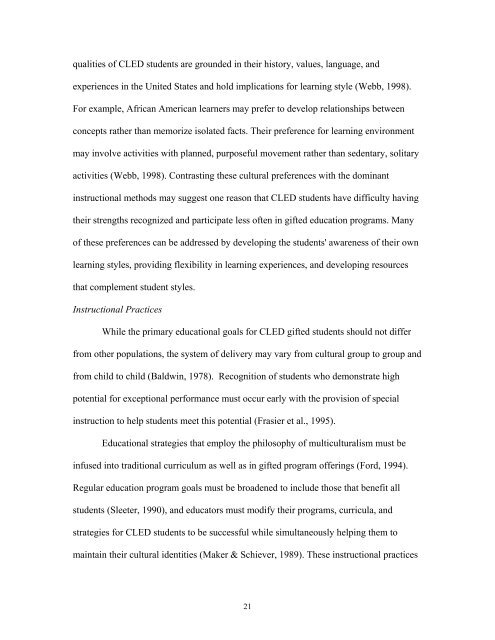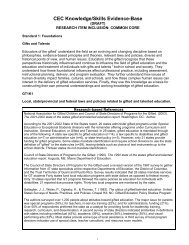Chapter One An Introduction to the Topic of Cultural Diversity - NAGC
Chapter One An Introduction to the Topic of Cultural Diversity - NAGC
Chapter One An Introduction to the Topic of Cultural Diversity - NAGC
You also want an ePaper? Increase the reach of your titles
YUMPU automatically turns print PDFs into web optimized ePapers that Google loves.
qualities <strong>of</strong> CLED students are grounded in <strong>the</strong>ir his<strong>to</strong>ry, values, language, and<br />
experiences in <strong>the</strong> United States and hold implications for learning style (Webb, 1998).<br />
For example, African American learners may prefer <strong>to</strong> develop relationships between<br />
concepts ra<strong>the</strong>r than memorize isolated facts. Their preference for learning environment<br />
may involve activities with planned, purposeful movement ra<strong>the</strong>r than sedentary, solitary<br />
activities (Webb, 1998). Contrasting <strong>the</strong>se cultural preferences with <strong>the</strong> dominant<br />
instructional methods may suggest one reason that CLED students have difficulty having<br />
<strong>the</strong>ir strengths recognized and participate less <strong>of</strong>ten in gifted education programs. Many<br />
<strong>of</strong> <strong>the</strong>se preferences can be addressed by developing <strong>the</strong> students' awareness <strong>of</strong> <strong>the</strong>ir own<br />
learning styles, providing flexibility in learning experiences, and developing resources<br />
that complement student styles.<br />
Instructional Practices<br />
While <strong>the</strong> primary educational goals for CLED gifted students should not differ<br />
from o<strong>the</strong>r populations, <strong>the</strong> system <strong>of</strong> delivery may vary from cultural group <strong>to</strong> group and<br />
from child <strong>to</strong> child (Baldwin, 1978). Recognition <strong>of</strong> students who demonstrate high<br />
potential for exceptional performance must occur early with <strong>the</strong> provision <strong>of</strong> special<br />
instruction <strong>to</strong> help students meet this potential (Frasier et al., 1995).<br />
Educational strategies that employ <strong>the</strong> philosophy <strong>of</strong> multiculturalism must be<br />
infused in<strong>to</strong> traditional curriculum as well as in gifted program <strong>of</strong>ferings (Ford, 1994).<br />
Regular education program goals must be broadened <strong>to</strong> include those that benefit all<br />
students (Sleeter, 1990), and educa<strong>to</strong>rs must modify <strong>the</strong>ir programs, curricula, and<br />
strategies for CLED students <strong>to</strong> be successful while simultaneously helping <strong>the</strong>m <strong>to</strong><br />
maintain <strong>the</strong>ir cultural identities (Maker & Schiever, 1989). These instructional practices<br />
21

















